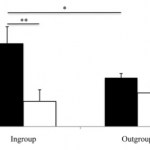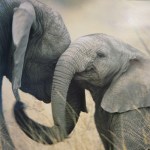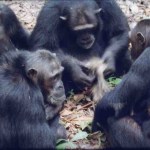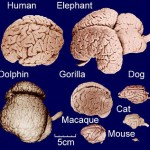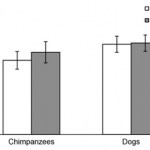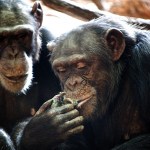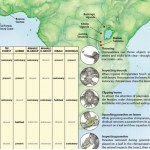Chimpanzee
Just one more example of how much humans and chimpanzees have in common. Check out this podcast describing wild chimpanzees seen drinking fermented tree sap as well as the video below.
Supplement video uploaded by the study's authors (Hockings et al., Royal Society Open Science, 2015) on Youtube.
Sources:
Scientific American
KJ Hockings, N Bryson-Morrison, S Carvalho, M Fujisawa, T Humle, WC McGrew, M Nakamura, G Ohashi, Y Yamanashi, G Yamakoshi, T Matsuzawa. Tools to tipple: ethanol ingestion by wild chimpanzees using leaf-sponges. Royal Society Open Science. DOI: 10.1098/rsos.150150 (…
As a follow up to the blog on heart disease in chimpanzees, a reader asked if chimpanzees ever develop congestive heart failure. The answer is yes, this is a common cause of death in these animals. However, the pathology differs from humans. For humans, heart disease usually results from coronary artery atherosclerosis, which blocks the blood supply to the heart muscle resulting in reduced or diminished oxygen and nutrient delivery. In contrast, heart disease in chimpanzees is more commonly attributed to interstitial myocardial fibrosis whose origins are unknown. Moreover…
Human infants have one important job during the first years of life, and that is to learn about the world and their culture from their parents and other caregivers. But what is learning? I've previously written that Hungarian developmental psychologists Gergely and Csibra have defined learning as the acquisition of new, generalizable knowledge that can later be used within a new context. Further, they have posited that evolution has prepared humans to learn generalizable knowledge from their caregivers. They proposed an elegant hypothesis: that a specialized innate pedagogy mechanism - called…
What is learning?
Most psychologists (indeed, most people in general) would agree that learning is the acquisition of new knowledge, or new behaviors, or new skills. Hungarian psychologists Gergely and Csibra offer a deceptively simple description: "Learning involves acquiring new information and using it later when necessary." What this means is that learning requires the generalization of information to new situations - new people, objects, locations, or events. The problem is that any particular piece of information that a human or animal receives is situated within a particular context…
You know that old phrase, "monkey see, monkey do"? Well, there might be something to it, except that chimpanzees aren't monkeys. (Sadly, "ape see, ape do" just doesn't have the same ring to it.) A new paper published today in PLoS ONE has found evidence that chimpanzees have contagious yawning - that is, they can "catch" yawns from watching other chimpanzees yawning - but (and here's the interesting part) only when the chimp that they're watching is a friend.
At first, scientists thought that contagious yawning was the result of a releasing mechanism - in other words, seeing someone yawn…
I was reading Christie's excellent post (and you should too) on GoDaddy CEO Bob Parsons' elephant killing incident (is it too early to be calling this #ElephantGate?)
Although I don't know quite enough about what is going on in Zimbabwe, I tend to err on the side of not intentionally killing elephants because - as I argued for the case of chimpanzees - they are very likely self-aware.
I wrote:
There is another important cognitive capacity that unites animals with high encephalization quotients (the ratio of brain to body size - I recommend going back to read my earlier post for the context…
A new piece by me today at the Scientific American Guest Blog, on some exciting news from the Jane Goodall Institute and Duke University:
Fifty years ago, in the summer of 1960 - the same year that a US satellite snapped the first photo of the Earth from space, the same year that the CERN particle accelerator became operational, the same year that the Beatles got their name - a 26-year-old Jane Goodall got on a plane in London and went for the first time to Gombe Stream Game Reserve, in Tanzania. She carried with her only a notebook and some old binoculars. Almost every day since the day…
Eric M. Johnson and I spent about 45 minutes discussing "evolutionary psychology beyond sex" last night, which you can see today on Bloggingheads "Science Saturday."
Or just watch it here:
"Two chimps had been shut out of their shelter by mistake during a cold rain storm. They were standing dejeted, water streaming down their shivering bodies, when Professor Köhler chanced to pass." Upon opening the door for the two chimps, Dr. James Leuba recounts, "instead of scampering in without more ado, as many a child would have done, each of them delayed entering the warm shelter long enough to throw its arms around his benefactor in a frenzy of satisfaction."
"Chimpanzees," primatologist Frans de Waal points out, "do not normally hug their caretakers for no reason." It's a compelling…
Non-human primate, that is.
Ape actor Peter Elliott shares his knowledge of chimpanzee and gorilla vocabulary and facial expressions.
via IMDb:
Peter Elliott is the film industry's primary primate. He both as a performer, in films like Missing Link and The Island of Doctor Moreau, and as a choreographer of other performers, as in Gorillas in the Mist and Congo. He also teaches animal study at London's Central School of Speech and Drama.
The National Institutes of Health announced that by 2011 it will transfer almost two hundred chimpanzees from the Alamogordo Primate Facility in New Mexico to a lab in San Antonio, Texas, lab for use in invasive research. In 1995, the NIH announced a moratorium on the breeding of chimps in federally-supported labs, and as a result, scientists have developed alternative ways to investigate diseases. But there are still viruses, such as hepatitis C and HIV, that other species simply can't contract. This fact, some argue, makes it prudent to subject chimps to this sort of biomedical testing.…
The awesome videos just keep on coming. Check out this one from National Geographic.
A juvenile chimp and her mother set out to do some fishing for termites in Congo's Goualougo Triangle, but the juvenile spots something interesting - an apparently not-so-well hidden camera - and investigates. I think it's so fascinating to see how the chimp approaches and investigates a new object. First by visually examining it, then by poking with a stick, and then by feeling it with her hand. Unfortunately, I can't embed it here, so go check it out on the Nat Geo site!
The skeletons of Lucy (left) and Kadanuumuu (right). Both belong to the early human species Australopithecus afarensis. (Images not to scale.)
I never fully appreciated how small Lucy was until I saw her bones for myself. Photographs and restorations of her and her kin within the species Australopithecus afarensis had never really given me a proper sense of scale, and when I looked over her incomplete skeleton - formally known as specimen A.L. 288-1 - I was struck by her diminutive proportions. In life she would have only been about three and a half feet tall. Her physical stature seemed…
Dogs are particularly good at tasks that involve communicating or cooperating with humans, which has led some researchers to speculate that they are really good at solving social tasks, more generally. For example, dogs can figure out where a human's attention is, are really good at picking up on eye-gaze and finger pointing cues, distinguish among different individual humans (by contrast, humans are really bad at distinguishing among different individual monkeys, for example), and at least in one outstanding case, are capable of "fast mapping."
Relative to non-human primates, domestic dogs…
Bonobo Week continues! I'm donating whatever proceeds I receive from my blogging shenanigans for the entire month of June to help the bonobos at Lola Ya Bonobo.
Imagine that you're wandering in the desert and you come across two magic lamps. One lamp grants three wishes. It's your standard sort of magic lamp with a genie in it. (No wishing for extra wishes, of course.) The second magic lamp is, well, a moody magic lamp. It's inconsistent. Sometimes it grants one wish, and sometimes it grants seven wishes. But the thing is, you don't know for sure whether, when you rub the lamp and genie pops…
A few weeks ago I emailed Vanessa Woods and asked her pretty please if I could review her book. After reading all of the bonobo and chimpanzee papers written by Vanessa and her husband Brian Hare (both now at Duke) over the years, as well as their research on domesticated dogs and silver foxes (some of which I wrote about on the old blog), I couldn't wait to check out the book. So I was super excited to find it waiting in my department mailbox this past Wednesday morning. By Friday night, I had read the book cover to cover.
So, here's the short review: read this book.
And, okay, watch this…
Today is the big day!
And not merely because it is TGIF* day.
The theme "everything you know is sort of wrong" is familiar to readers on this blog. It is an underlying theme for much of what happens here. Every now and then that theme is manifest overtly, as in the Falsehoods posts, which are, as we speak, being revised, expanded, and reissued.
Well, starting this evening and running for an indeterminate amount of time (but probably a few weeks or so) "Everything you know is sort of wrong" is not just a phrase to keep in your head all the time as you are walking around doing stuff. It's…
New research finds chimpanzees follow prestigious models when learning new tasks. Monika Thorpe / Creative CommonsIf one were to play psychiatrist to the natural world, most human beings would be committed for our certifiable obsession with other peoples' behavior. We compulsively examine, study, appraise, size up, and scope out what those around us are doing and then gossip with others about what we've seen or heard. New ideas or behaviors are especially compelling and will often have cultural critics…
Yesterday, I wrote about this paper on chimpanzees learning (or not) to spit water into a tube to retrieve a peanut.
I was so very sad to see that there were no supplementary materials included with the paper. No awesome videos of chimps spitting water into a tube to share with you.
So I sent an email to Dr. Claudio Tennie, the lead author of the paper, and postdoc at the Max Planck Institute for Evolutionary Anthropology in Leipzig, inquiring as to the possible existence of a video. It seems that there aren't any available. But, he gave me a link to an awesome video already on youtube of an…
What is culture? One simple definition might be: a distinctive behavior shared by two or more individuals, which persists over time, and that ignorant individuals acquire through socially-aided learning.
There are at least four different ways to learn a particular behavior or problem-solving strategy. That is to say, there are four different ways to learn. The first is social facilitation, in which one individual does the same thing as the demonstrator at the same time. Essentially this is a situation of on-line matching of motor actions. For example, I might learn the steps to a complicated…



